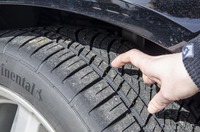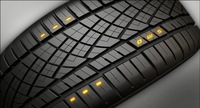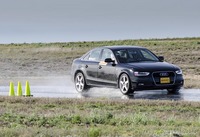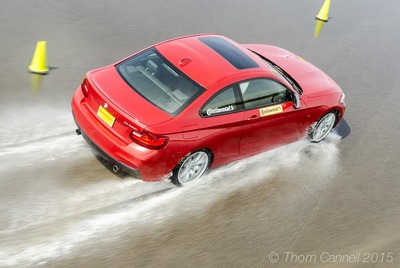Continental DWS06 Real World Road Test By Thom Cannell
By Thom Cannell
Senior Editor
Michigan Bureau
The Auto Channel
There’s a story behind the new Continental Extreme Contact DWS06, a new premium tire that delivers. All too often promises don’t work out the way you wish. Claims are inflated, inaccurate, or just plain false. Not so with the updated Conti DWS.
In fairness, recent declarations that new tires are better than their predecessors have proven true, and even understated. This premium tire claims to better its predecessor, the Continental Extreme Contact DWS by a mere 8-10% in the Dry, the Wet, and in the Snow—hence the DWS naming. You’d not expect to feel such a small difference, but you can.
In early testing we scrutinized this new tire in the wet, extremely wet, and in the dry. Each of Continental Tire Company’s claims proved to be true. However that day-long test, as fun as it was to play with fast cars on race tracks, skid pads, and full wet-stop testing troughs, isn’t the real world. So we put a set onto a staff car. As a bonus, a friend did the same after our initial review.
 |
Here’s how Continental’s new Extreme Contact DWS06 tires are improved over their DWS sibling. Changes in the structure of the tread add more biting edges and improve cornering. Like most new tires, Continental uses slica (very pure and specifically sized sand) added for tread flexibility and new processes improve the way polymers bond to other polymers—natural and artificial rubber among them. The big tread blocks have x-shaped sipes—razor cuts—to further increase biting edges as the contact patch rolls forward.
 |
According to Continental, the ExtremeContact DWS06 is only 1-10% better than its predecessor in each area of performance, Dry, Wet, or Snow—which we have yet to test, thank goodness! We assure you, the changes can be felt when turning wet corners, dry corners, and when on very wet simulated highways. Along with these perceptible improvement, the new tire mounts to your wheels more perfectly, and all DWS06 tires use two plys to create better impact resistance, especially resistance to potholes.
 |
Currently Continental manufacturers the Extreme Contact DWS06 in 55 sizes. These range from 16” to 22” in diameter with section widths as low as 30 and up to an aspect ratio of 50 in W or Y speed ratings.
One of the most important attributes of a new set of tires is how they make you feel when you drive distances in the rain or dry, how they react in daily commutes when your mind might wander into the upcoming work day. Thus we’re happy to repeat a seemingly innocuous comment, “I felt much more confident when driving”. Along with that note was the report that the Continental Extreme Contact DWS06 was quieter and handling was much improved. Obviously that feeds into the overall confidence.
 |
Interestingly a friend who manages a Sears Auto Center put a set on his Mercedes at our suggestion. His C Class is approaching its tenth year and had been riding on very highly rated tires. All he wanted was good tires, ones hopefully somewhat better than those being replaced. What he gained was much much more. “It was like having a new car, one with more grip though riding softer and quieter, and with much more assurance. Then, in the rain, it sliced through curb-to-curb water with complete assurance.”
We think that says it all, at least until we can get some snow miles under the chassis. For that, after the first few Northern snowfalls, when expecting 6-9” of snow, we still recommend winter tires. If you never see more than 2-4” of snow try the Extreme Contact DWS06, they’re designed for it.



